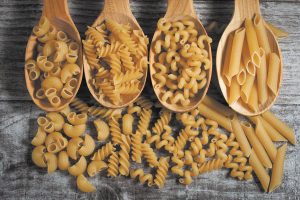October 1, 2020
Mangiamo La Pasta (Let’s Eat Pasta)
 By Mary Schricker Gemberling
By Mary Schricker Gemberling
According to a survey conducted by the National Pasta Association, pasta lovers eat their favorite food seven times a month! This is most likely because pasta is a versatile dish which can easily fit into a healthy lifestyle. Pasta boosts energy, satisfies hunger, tastes great and can be prepared in countless ways. When asked what food they could not live without, one group surveyed chose pasta, even instead
of chocolate.
Why all this talk of pasta? No, I haven’t lost my noodle! October is actually National Pasta Month, and October 6 is National Noodle Day . If you missed National Lasagna Day in July or National Linguini Day in September, you still have plenty of time to celebrate oodles of noodles.

Although I wouldn’t choose it over chocolate, pasta is one of my favorite foods to prepare as well as eat. It looks like I’m not alone, since Americans eat approximately 20 pounds of pasta each year. Thomas Jefferson introduced pasta to America after first tasting it in Naples, Italy while he was the American Ambassador to France in 1785. In 1789
he returned to the United States with the first pasta machine and crates of macaroni. Pasta became a common North American dish in the late nineteenth century with the surge of Italian immigration.
The history of pasta is difficult to trace. The word itself translates to ‘paste’ in Italian. This is a reference to the dough made from a combination of flour and water or eggs, all simple components that have been around for centuries. This makes it hard to differentiate pasta from other ancient dishes made from the same ingredients. In addition, since pasta has long been a food of the common people, it has not received as much attention.
Archaeologists believe that central Asia is most likely the first area to have produced noodles thousands of years ago. From Asia it traveled westward; how it reached Europe is unclear but some believe that nomadic Arabs are responsible for bringing early forms of pasta westward. In as early as 500
BC Italians served testaroli, a type of pasta combining water, flour, and salt and cut into triangular shapes. Eventually the process was refined, and Durham wheat became the ingredient of choice for pasta flour.
Over time because of pasta’s affordability, shelf life, and versatility, it became firmly rooted in Italian culture. The warm Mediterranean climate of Italy is suited to growing fish, vegetables and herbs, which means that Italians could get creative with a delicious variety of pasta sauces. So creative that today the average person in Italy eats 51 pounds of pasta
a year!
There are over 600 different shapes of pasta which can be made into an infinite number of meals. It is the shape of the pasta that gives it its name, I can’t say that I have a favorite one, but Americans in a recent survey chose Spaghetti as their favorite shape. Fifty-four percent of Americans keep 1-4 packages of pasta in their pantry at all times. I actually prefer fresh pasta; it’s not necessarily better than dried, but it is made
differently and does taste different. Dry pastas are made with just wheat and water, and fresh pastas add egg to the dough.
When Gary and I were in Italy a few years ago pasta was our choice for almost every lunch or dinner. We even took a cooking class and learned to make gnocchi, which was easy and tasted different than ours back home. I asked our Italian instructor why the pasta in Italy tasted so much better than in the United States? He said it was part ambiance and part ingredients. After all, we were in Italy where most of our food and wine was enjoyed outdoors at cozy little tables set in quaint settings. What’s not to like? The other factor that might have influenced the flavor was a combination of the type of flour, the local water, and the use of salt which is frowned upon the United States.
My favorite pasta out of all the meals we had in Italy was Cacio e pepe, which means cheese and pepper. The dish is very simple and consists of only three ingredients: black pepper, grated Pecorino Romano cheese, and spaghetti. The pasta is prepared in boiling salted water. It is then poured into the grated pecorino mixed with black pepper, with a little of the hot, starchy, cooking water. The heat melts the cheese, and the starch in the water bind the paper and cheese to the pasta. The origin of the recipe is very ancient and dates back to the Roman Empire. For centuries, cacio e pepe has been the perfect meal of the Roman shepherds.The dried pasta, aged pecorino and black pepper are easy to carry and hard to spoil.
Whatever your skill level in the kitchen there are many pasta dishes you can prepare to wow your family and friends. Whether in Italy or your own back yard, a big bowl of pasta, some warm bread, and a glass of wine is a perfect way to end any day.
“Everything you see, I owe to pasta.”
…………. Sophia Loren
Mary, a former writer and educator, is the author of three books: The West End Kid, A Labor of Love, and Hotel Blackhawk; A Century of Elegance.
Filed Under: History
Trackback URL: https://www.50pluslife.com/2020/10/01/lets-eat-pasta/trackback/


